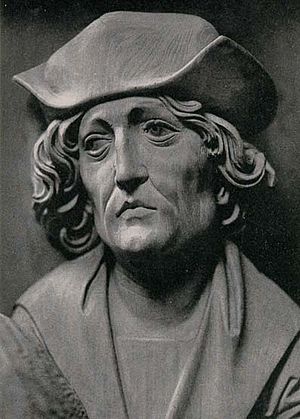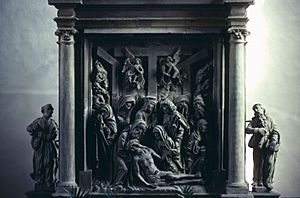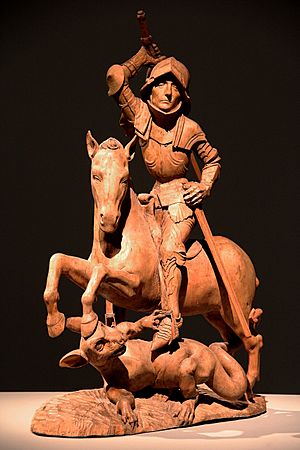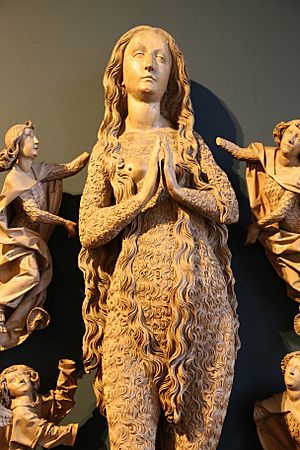Tilman Riemenschneider facts for kids
Quick facts for kids
Tilman Riemenschneider
|
|
|---|---|

Supposed self-portrait of Tilman Riemenschneider.
|
|
| Born | (Catalan) 1460 Heiligenstadt im Eichsfeld, Holy Roman Empire
|
| Died | 7 July 1531 |
| Nationality | German |
| Occupation | sculptor |
| Years active | (Catalan) 1473 until 1527 |
Tilman Riemenschneider (born around 1460 – died July 7, 1531) was a famous German artist. He was a sculptor and a woodcarver who worked in Würzburg, Germany, starting in 1483. He was one of the most active and talented sculptors during a time when art was changing from the late Gothic style to the Renaissance style. He was a master at carving both stone and limewood.
Contents
About Tilman Riemenschneider
Tilman Riemenschneider was born around 1460 in a town called Heilbad Heiligenstadt in what is now Thuringia, Germany.
When Tilman was about five years old, his family had to leave their home. This was because his father was involved in a big political problem called the Mainzer Stiftsfehde. They moved to Osterode, where his father became a Master of the Mint. This was an important job where he helped make coins. Tilman spent his childhood years there.
Tilman probably first visited Würzburg when he was about 18, around 1478 or 1479. His uncle worked there as a financial advisor to the bishop. Around 1473, Tilman started learning how to sculpt and carve wood. He likely traveled to different workshops in places like Strasbourg or Ulm. This was a common way for apprentices to learn and gain experience back then. We don't know much about this time, but he probably saw the work of another artist named Martin Schongauer, whose copper engravings later inspired him.
Starting His Career
In 1483, Tilman settled in Würzburg. On December 7, 1483, he joined the Saint Luke's Guild. This was a special group for painters, sculptors, and glass workers. He started as a painter's assistant. On February 28, 1485, he married Anna Schmidt. She was a widow with three sons. This marriage helped him become a master craftsman and open his own workshop.
In 1485, Riemenschneider also became a citizen of Würzburg. This allowed him to become a master craftsman and open his workshop in Franziskanergasse, in his wife's home.
His first known work is a gravestone for Eberhard von Grumbach in the church at Rimpar. He soon started getting many orders from towns like Würzburg. One of his first big works was the Franziskusaltar in the St Jakobskirche in Rothenburg ob der Tauber. In 1490, the town of Münnerstadt ordered a large altarpiece for their church. It featured a carving of Mary Magdalene with six angels. In 1491, Würzburg ordered two life-sized stone figures of Adam and Eve for the Marienkapelle church.
Family and Fame
In 1494, Tilman's first wife passed away. He had three stepsons and a daughter. In 1497, he married again to Anna Rappolt. They had two daughters and three sons. Many of his children seemed to have inherited his artistic talent. In 1495, he created a beautiful statue of Mary with a child for a church in Würzburg.
More important projects came his way. In 1496, Riemenschneider was asked to carve the tomb of Prince-Bishop Rudolf von Scherenberg for Würzburg Cathedral. He finished it in 1499. That same year, he received an order for the Imperial tomb at Bamberg Cathedral, which he finished in 1513.
By 1500, Tilman Riemenschneider was very famous and wealthy in Würzburg. He owned several houses and even vineyards. His busy workshop employed up to 40 apprentices who helped with woodcarving, sculpting, and painting.
Politics and Later Life
In November 1504, Riemenschneider became a member of the Unterrat, which was a town council in Würzburg. He held this position until 1525. Being a councilman gave him social status and helped him get many big and profitable art orders.
He married two more times, first to Margaretha Wurzbach in 1508, and then to another woman named Margarethe in 1520. From 1509 to 1522, he was a member of the Oberrat four times. In 1520 and 1521, Riemenschneider even served as a mayor of Würzburg. In the Middle Ages, two people usually held this position at the same time.
Because he was so busy with politics and had many art orders, his apprentices started doing more of the actual carving work in his workshop. Art experts can sometimes tell which parts were made by different workers.
During the German Peasants' War in 1525, Riemenschneider was one of the council members who refused to fight against the revolting peasants. After the peasants' army was defeated, the entire town council, including Riemenschneider, was arrested and put in prison. They were held in Marienberg Fortress. There's a story that his hands were broken during torture, which ended his art career. However, this is now believed to be just a legend that started much later. After two months, he was set free, but he lost most of his property. After this, he only received one known order in 1527. He lived a quiet life with his fourth wife until he passed away on July 7, 1531, in Würzburg. His son Jörg continued the workshop after his death.
After he died, Riemenschneider was mostly forgotten as an artist, except for the two gravestones he made for Bishops Rudolf von Scherenberg and Lorenz von Bibra in Würzburg Cathedral. It wasn't until 1822, when his own gravestone was found, that people truly recognized how important he was in Gothic sculpture. Unlike other famous artists of his time, Riemenschneider became truly famous only after his death.
Riemenschneider's Art Style
Tilman Riemenschneider's sculptures and woodcarvings are in the late Gothic style. However, his later works also show signs of the mannerist style, which was a step towards the Renaissance. For example, the tomb he made for Lorenz von Bibra is seen as one of the artworks that marks the change from Gothic to Renaissance art.
His art is known for how expressive the faces of his figures are. They often look like they are thinking deeply. Their clothes are also very detailed and have many rich folds. This focus on showing inner feelings makes Riemenschneider's work special compared to artists who came before him.
Riemenschneider's early success came from how realistic and three-dimensional his works looked. He paid great attention to shaping the folds of the clothing. The way he sculpted clothes, along with the typical oval faces and almond-shaped eyes, was similar to art from the Upper Rhine region in the 1470s. This suggests he might have learned his skills there or in Ulm. Later, his works became a bit less bulky, which made them easier to produce.
Riemenschneider is considered one of the first sculptors in the 15th century who did not have all his figures painted. Before the 1490s, almost every sculpture was painted in many layers by a different artist. Often, the painter was more admired than the sculptor. Art historians still discuss why Riemenschneider started making art where the wood was visible.
Riemenschneider worked with both wood and stone. It is thought that he learned stone carving first and then started wood carving. Some of his wooden figures, even though they are clearly his work, show small signs that he might have been less perfect with wood choice or handling.
Art experts like Souren Melikian believe Riemenschneider's best work, such as the Virgin listening to the Annunciation, is as good as the oil paintings of Albrecht Dürer. Art historian Kenneth Clark saw Riemenschneider's figures as showing the deep religious feelings in Germany in the late 1400s. He also thought they hinted at the coming Reformation. Some of his students or followers included Peter Breuer and Philipp Koch.
Famous Artworks
The largest collection of Riemenschneider's work, with 81 pieces, can be found in the Mainfränkisches Museum inside the Fortress Marienberg in Würzburg.
Some of his most important works include:
- Hassenbacher Vesperbild, in the church of Hassenbach, around 1490, made of wood.
- Altar of the Farewell of the Apostles, in the Allerheiligenkirche, Kleinschwarzenlohe near Nuremberg, 1491.
- Altar Piece, Maria Magdalena, Münnerstadt, 1490/1492.
- Adam and Eve, originally from Marienkapelle Würzburg, now in the Mainfränkisches Museum, 1491/1493.
- Sculpture of Bishop Rudolf von Scherenberg, Würzburg Cathedral, 1496/1499.
- Emperor's Tomb, Bamberg Cathedral, 1499/1513.
- Mary Salome and Zebedee, Würzburg 1501-5, now in the Victoria and Albert Museum, London.
- Saint Anne and her three husbands, Munich, Bayerisches Nationalmuseum, 1505/1510, made of wood.
- Grieving Maria, Würzburg, Mainfränkisches Museum, around 1505.
- Altar of Maria, Creglingen, around 1505/1508, made of wood.
- Holy Blood Altar, Jakobskirche, Rothenburg ob der Tauber, 1501—1505, made of wood.
- Tomb of Bishop Lorenz of Bibra, Würzburg Cathedral, 1520/1522.
- Madonna of the Rosary, in the pilgrim's church of Maria im Weingarten, near Volkach, around 1521/1524.
- The Assumption of the Virgin, the main part of the Creglingen altarpiece, Herrgottskirche, Creglingen, 1495–1499.
In Books and Stories
Tilman Riemenschneider's art has inspired writers. In the 1930 book Narcissus and Goldmund by Hermann Hesse, one of the main characters, Goldmund, learns from a master sculptor. This master sculptor is a respected person in his town, and his character seems to be based on Riemenschneider. He helps Goldmund with his art and also shows a different personality compared to Goldmund.
Hesse describes Riemenschneider's statue of Mary with child, which is in the Pfarrkirche St Bernard in Würzburg, saying: "Dreamily she gazes out from her glass case, far away from our world... in her gracefulness and distinction she is refined to a degree of perfection far above that of mankind today."
Also, the first Vicky Bliss mystery novel, "Borrower of the Night" (1973) by Elizabeth Peters, is about finding a missing Riemenschneider sculpture. Most of the story takes place in Rothenburg ob der Tauber.
Images for kids
See also
 In Spanish: Tilman Riemenschneider para niños
In Spanish: Tilman Riemenschneider para niños









